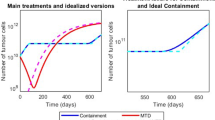Abstract
We present results from a mathematical analysis that is aimed at finding the best way to sequence the three traditional cancer treatments: surgery (S), chemotherapy (C), and radiotherapy (R). The mathematical model tracks the temporal evolution of the primary tumor and its associated metastases, and incorporates the primary tumor's effect on the dormancy and growth of the metastases. We show that the SCR schedule (i.e., surgery followed by chemotherapy followed by radiotherapy) achieves a higher cure probability than SRC if the primary tumor is sufficiently large or if the metastatic population is sufficiently large relative to the primary tumor. We also show that a novel schedule, SRCR, which splits the radiotherapy regimen into two disjoint portions, is optimal among all schedules, provided that the patient's dormant metastatic tumors do not become vascularized within about 40 days after surgery.
Similar content being viewed by others
References
Recht A, Come SE, Henderson IC, Gelman RS, Silver B, Hayes DF, Shulman LN, Harris JR: The sequencing of chemo-therapy and radiation therapy after conservative surgery for early-stage breast cancer. N Engl J Med 334: 1356–1361, 1996
Bonadonna G: Current and future trends in the multidisciplin-ary approach for high-risk breast cancer. The experience of the Milan Cancer Institute. Eur J Cancer 32A: 209–214, 1996
Weidner N, Semple JP, Welch WR, Folkman J: Tumor an-giogenesis and metastasis - correlation in invasive breast carcinoma. N Engl J Med 324: 1–8, 1991
Chambers AF, MacDonald IC, Schmidt EE, Koop S, Morris VL, Khokha R, Groom AC: Steps in tumor metastasis: new concepts from intravital videomicroscopy. Cancer Metast Rev 14: 279–301, 1995
Luzzi KJ, MacDonald IC, Schmidt EE, Kerkvliet N, Morris VL, Chambers AF, Groom AC: Multistep nature of metastatic inefficiency: dormancy of solitary cells after successful extravasation and limited survival of early micrometastases. Amer J Pathol 153: 865–873, 1998
O'Reilly MS, Holmgren L, Shing Y, Chen C, Rosenthal RA, Moses M, Lane WS, Cao Y, Sage EH, Folkman J: Angiostatin: a novel angiogenesis inhibitor that mediates the suppression of metastases by a Lewis lung carcinoma. Cell 79: 315–328, 1994
Holmgren L, O'Reilly MS, Folkman J: Dormancy of micro-metastases: balanced proliferation and apoptosis in the presence of angiogenesis suppression. Nature Med 1: 149–153, 1995
Browder T, Butterfield CE, Kräling BM, Shi B, Marshall B, O'Reilly MS, Folkman J: Antiangiogenic scheduling of chemotherapy improves efficacy against experimental drug-resistant cancer. Cancer Res 60: 1878–1886, 2000
Beil DR, Wein LM: Analysis and comparison of multimodal cancer treatments. To appear in IMA Journal of Mathematics Applied in Medicine and Biology, 2002
Skipper HE, Schabel Jr FM, Wilcox WS: Experimental evaluation of potential anticancer agents. XIII. On the criteria and kinetics associated with ‘curability’ of experimental leukemia. Cancer Chemotherap Rep 35: 1–111, 1964
Fowler JF: The linear-quadratic formula and progress in fractionated radiotherapy. Br J Radiol 62: 679–694, 1989
Folkman J: Clinical applications of research on angiogenesis. In: Flier JS, Underhill LH (eds) Seminars in Medicine of the Beth Israel Hospital, Boston. N Engl J Med 333: 1757–1763, 1995
Landry J, Freyer JP, Sutherland RM: A model for the growth of multicellular spheroids. Cell Tissue Kinet 15: 585–594, 1982
Camphausen K, Moses MA, Beecken WD, Khan MK, Folkman J, O'Reilly MS: Radiation therapy to a primary tumor accelerates metastatic growth in mice. Cancer Res 61: 2207–2211, 2001
Tucker SL, Taylor JMG: Improved models of tumor cure. Int J Radiat Biol 70: 539–553, 1996
Hanahan D, Folkman J: Patterns and emerging mechanisms of the angiogenic switch during tumorigenesis. Cell 86: 353–364, 1996
Demicheli R, Terenziani M, Bonadonna G: Estimate of tumor growth time for breast cancer local recurrences: rapid growth after wake-up. Breast Cancer Res Treat 51: 133–137, 1998
Tubiana M, Koscielny S: Natural history of human breast cancer: recent data and clinical implications. Breast Cancer Res Treat 18: 125–140, 1991
Lewis AM, Su M, Doty J, Chen Y, Pardo FS: Relationship between intrinsic radiation sensitivity and metastatic potential. Int J Radiat Oncol Biol Phys 34: 103–110, 1996
Koscielny S, Tubiana M, Lê MG, Valleron AJ, Mouriesse H, Contesso G, Sarrazin D: Breast cancer: relationship between the size of the primary tumour and the probability of metastatic dissemination. Br J Cancer 49: 709–715, 1984
Koscielny S, Tubiana M: The link between local recurrence and distant metastases in human breast cancer. Int J Rad Oncol Biol Phys 43: 11–24, 1999
Bonadonna G, Valagussa P, Brambilla C, Ferrari L, Moliterni A, Tereziani M, Zambetti M: Primary chemotherapy in operable breast cancer: eight-year experience at the Milan Cancer Institute. J Clin Oncol, 16: 93–100, 1998
Tubiana M, Arriagada R, Cosset J-M: Sequencing of drugs and radiation: the integrated alternating regimen. Cancer 55: 2131–2139, 1985
Graeber TG, Osmanian C, Jacks T, Housman DE, Koch CJ, Lowe SW, Giaccia AJ: Hypoxia-mediated selection of cells with diminished apoptotic potential in solid tumors. Nature, 397: 88–91, 1996
Coldman AJ, Goldie JH: A model for the resistance of tumor cells to cancer chemotherapeutic agents. Math Biosci 65: 291–307, 1983
The Ludwig Breast Cancer Study Group: Combination adjuvant chemotherapy for node-positive breast cancer: inadequacy of a single perioperative cycle. N Engl J Med 319: 677–683, 1988
Sertoli MR, Bruzzi P, Pronzato P, Queirolo P, Amoroso D, Delmastro L, Venturini M, Vigani A, Bertelli G, Campora E, Boccardo F, Monzeglio C, Paganini E, Pastorino G, Canavese G, Catturich A, Cafiero F, Vecchio C, Miccoli P, Rubagotti A, Rosso R: Randomized cooperative study of perioperative chemotherapy in breast cancer. J Clin Oncol 13: 2712–2721, 1995
Hall EJ: Radiobiology for the Radiologist. 4th edn, Lippincott, Philadelphia, 1994
Author information
Authors and Affiliations
Rights and permissions
About this article
Cite this article
Beil, D.R., Wein, L.M. Sequencing Surgery, Radiotherapy and Chemotherapy: Insights from a Mathematical Analysis. Breast Cancer Res Treat 74, 279–286 (2002). https://doi.org/10.1023/A:1016357311845
Issue Date:
DOI: https://doi.org/10.1023/A:1016357311845




